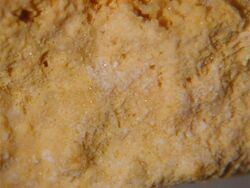Chemistry:Avogadrite
From HandWiki
| Avogadrite | |
|---|---|
 Ferruccite (white) on avogadrite (yellow-brownish), picture size: 5 mm | |
| General | |
| Category | Halide mineral |
| Formula (repeating unit) | (K,Cs)BF4 |
| Strunz classification | 3.CA.10 |
| Crystal system | Orthorhombic |
| Crystal class | Dipyramidal (mmm) H-M symbol: (2/m 2/m 2/m) |
| Space group | Pnma |
| Unit cell | a = 8.6588, b = 5.48 c = 7.0299 [Å]; Z = 4 |
| Identification | |
| Color | Colorless to white, yellowish to reddish |
| Crystal habit | Tabular to platy octagonal crystals, tiny crystals, elongate |
| |re|er}} | Vitreous, greasy |
| Diaphaneity | Translucent |
| Specific gravity | 2.9 |
| Optical properties | Biaxial (-) |
| Refractive index | nα = 1.3239, nβ = 1.3245, nγ = 1.3247 |
| Birefringence | δ = 0.001 |
| 2V angle | 75°(meas), 58° (calc) |
| Other characteristics | Bitter taste |
| References | [1][2][3] |
Avogadrite ((K,Cs)BF4) is a potassium-caesium tetrafluoroborate in the halide class. Avogadrite crystallizes in the orthorhombic system (space group Pnma) with cell parameters a 8.66 Å, b 5.48 Å and c Å 7.03.
History
The mineral was discovered by the Italian mineralogist Ferruccio Zambonini in 1926. He analyzed several samples from the volcanic fumaroles close to Mount Vesuvius and from the Lipari islands. In nature, it can only be found as a sublimation product around volcanic fumaroles.[1] He named it after the Italian scientist Amedeo Avogadro (1776–1856).[5]
Bibliography
- Palache, P.; Berman H.; Frondel, C. (1960). "Dana's System of Mineralogy, Volume II: Halides, Nitrates, Borates, Carbonates, Sulfates, Phosphates, Arsenates, Tungstates, Molybdates, Etc. (Seventh Edition)" John Wiley and Sons, Inc., New York, pp. 97-98.
References
- ↑ 1.0 1.1 "Handbook of Mineralogy: Avogadrite". The Mineralogical Society of America. http://www.handbookofmineralogy.org/pdfs/AVOGADRITE.pdf.
- ↑ Avogadrite on Mindat.org
- ↑ Avogadrite data on Webmin
- ↑ Warr, L.N. (2021). "IMA–CNMNC approved mineral symbols". Mineralogical Magazine 85 (3): 291–320. doi:10.1180/mgm.2021.43. Bibcode: 2021MinM...85..291W.
- ↑ Zambonini, Ferruccio (1926). Sulla presenza, tra i prodotti dell'attuale attività del Vesuvio, di una varietà cesifera del fluoborato di potassio, (On the presence, among the products of Vesuvius, of a caesium-bearing variety of potassium fluoborate), Rend. Accad. Lincei. 6. pp. 644–649.
 |

